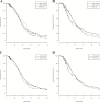Human TERT promoter mutation enables survival advantage from MGMT promoter methylation in IDH1 wild-type primary glioblastoma treated by standard chemoradiotherapy
- PMID: 27571882
- PMCID: PMC5464302
- DOI: 10.1093/neuonc/now189
Human TERT promoter mutation enables survival advantage from MGMT promoter methylation in IDH1 wild-type primary glioblastoma treated by standard chemoradiotherapy
Abstract
Background: Promoter mutation in the human telomerase reverse transcriptase gene (hTERT) occurs in ~75% of primary glioblastoma (GBM). Although the mutation appears to upregulate telomerase expression and contributes to the maintenance of telomere length, its clinical significance remains unclear.
Methods: We performed hTERT promoter genotyping on 303 isocitrate dehydrogenase 1 wild-type GBM tumors treated with standard chemoradiotherapy. We also stratified 190 GBM patients from the database of The Cancer Genome Atlas (TCGA) by hTERT gene expression. We analyzed overall and progression-free survival by Kaplan-Meier and Cox regression.
Results: We detected hTERT promoter mutation in 75% of the patients. When included as the only biomarker, hTERT mutation was not prognostic in our patient cohort by Cox regression analysis. However, when hTERT and O6-DNA methylguanine-methyltransferase (MGMT) were included together, we observed an interaction between these 2 factors. To further investigate this interaction, we performed pairwise comparison of the 4 patient subcohorts grouped by hTERT-MGMT status (MUT-M, WT-M, MUT-U, and WT-U). MGMT methylated patients showed improved survival only in the presence of hTERT promoter mutation: MUT-M versus MUT-U (overall survival of 28.3 vs 15.9 mos, log-rank P < .0001 and progression-free survival of 15.4 vs 7.86 mo, log-rank P < .0001). These results were confirmed by Cox analyses. Analogously, the cohort from TCGA demonstrated survival benefit of MGMT promoter methylation only in patients with high hTERT expression. In addition, hTERT mutation was negatively prognostic in our MGMT unmethylated patients, while the analogous association with high expression was not observed in the cohort from TCGA.
Conclusion: The prognostic influence of MGMT promoter methylation depends on hTERT promoter mutation. This interaction warrants further mechanistic investigation.
Keywords: MGMT promoter methylation; hTERT promoter mutation; overall survival; primary glioblastoma; progression free survival.
© The Author(s) 2017. Published by Oxford University Press on behalf of the Society for Neuro-Oncology. All rights reserved. For permissions, please e-mail: journals.permissions@oup.com
Figures


Similar articles
-
Prognostic value of MGMT promoter methylation and TP53 mutation in glioblastomas depends on IDH1 mutation.Asian Pac J Cancer Prev. 2014;15(24):10893-8. doi: 10.7314/apjcp.2014.15.24.10893. Asian Pac J Cancer Prev. 2014. PMID: 25605197
-
The Impact of IDH1 Mutation and MGMT Promoter Methylation on Recurrence-Free Interval in Glioblastoma Patients Treated With Radiotherapy and Chemotherapeutic Agents.Pathol Oncol Res. 2021 Apr 29;27:1609778. doi: 10.3389/pore.2021.1609778. eCollection 2021. Pathol Oncol Res. 2021. PMID: 34257620 Free PMC article.
-
Prognostic significance of telomerase-associated parameters in glioblastoma: effect of patient age.Neuro Oncol. 2013 Apr;15(4):423-32. doi: 10.1093/neuonc/nos329. Epub 2013 Feb 7. Neuro Oncol. 2013. PMID: 23393205 Free PMC article. Clinical Trial.
-
The prognostic value of MGMT promoter methylation in glioblastoma: A meta-analysis of clinical trials.J Cell Physiol. 2018 Jan;233(1):378-386. doi: 10.1002/jcp.25896. Epub 2017 May 16. J Cell Physiol. 2018. PMID: 28266716 Review.
-
The prognostic value of MGMT promoter status by pyrosequencing assay for glioblastoma patients' survival: a meta-analysis.World J Surg Oncol. 2016 Oct 12;14(1):261. doi: 10.1186/s12957-016-1012-4. World J Surg Oncol. 2016. PMID: 27733166 Free PMC article. Review.
Cited by
-
The C250T Mutation of TERTp Might Grant a Better Prognosis to Glioblastoma by Exerting Less Biological Effect on Telomeres and Chromosomes Than the C228T Mutation.Cancers (Basel). 2024 Feb 9;16(4):735. doi: 10.3390/cancers16040735. Cancers (Basel). 2024. PMID: 38398126 Free PMC article.
-
The interaction between TERT promoter mutation and MGMT promoter methylation on overall survival of glioma patients: a meta-analysis.BMC Cancer. 2020 Sep 21;20(1):897. doi: 10.1186/s12885-020-07364-5. BMC Cancer. 2020. PMID: 32957941 Free PMC article.
-
Intratumoral Susceptibility Signals Reflect Biomarker Status in Gliomas.Sci Rep. 2019 Nov 19;9(1):17080. doi: 10.1038/s41598-019-53629-w. Sci Rep. 2019. PMID: 31745161 Free PMC article.
-
Clinical insights gained by refining the 2016 WHO classification of diffuse gliomas with: EGFR amplification, TERT mutations, PTEN deletion and MGMT methylation.BMC Cancer. 2019 Oct 17;19(1):968. doi: 10.1186/s12885-019-6177-0. BMC Cancer. 2019. PMID: 31623593 Free PMC article.
-
Nogo receptor-vimentin interaction: a novel mechanism for the invasive activity of glioblastoma multiforme.Exp Mol Med. 2019 Oct 24;51(10):1-15. doi: 10.1038/s12276-019-0332-1. Exp Mol Med. 2019. PMID: 31649250 Free PMC article.
References
-
- Arita H, Narita Y, Fukushima S, et al. Upregulating mutations in the TERT promoter commonly occur in adult malignant gliomas and are strongly associated with total 1p19q loss. Acta Neuropathol. 2013;126(2):267–276. - PubMed
-
- Labussiere M, Boisselier B, Mokhtari K, et al. Combined analysis of TERT, EGFR, and IDH status defines distinct prognostic glioblastoma classes. Neurology. 2014;83(13):1200–1206. - PubMed
MeSH terms
Substances
Grants and funding
LinkOut - more resources
Full Text Sources
Other Literature Sources
Research Materials
Miscellaneous

